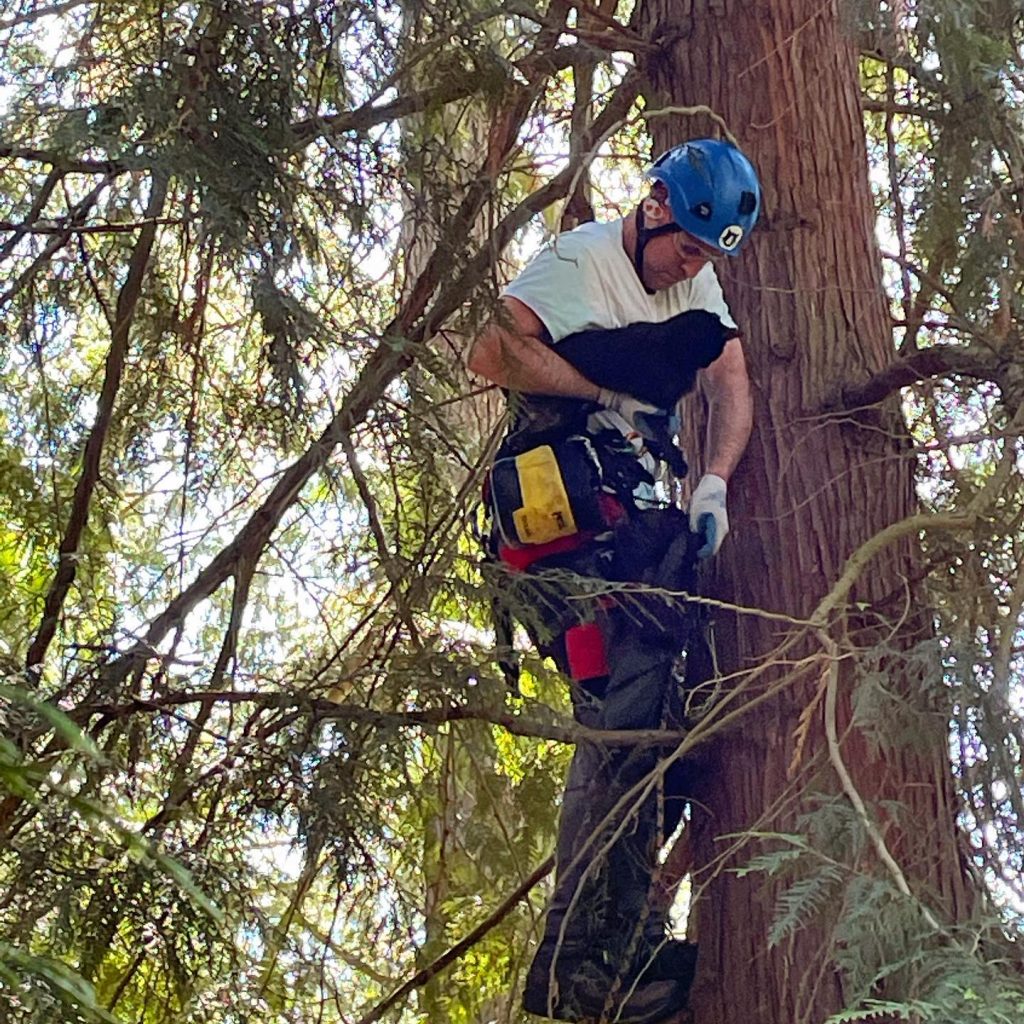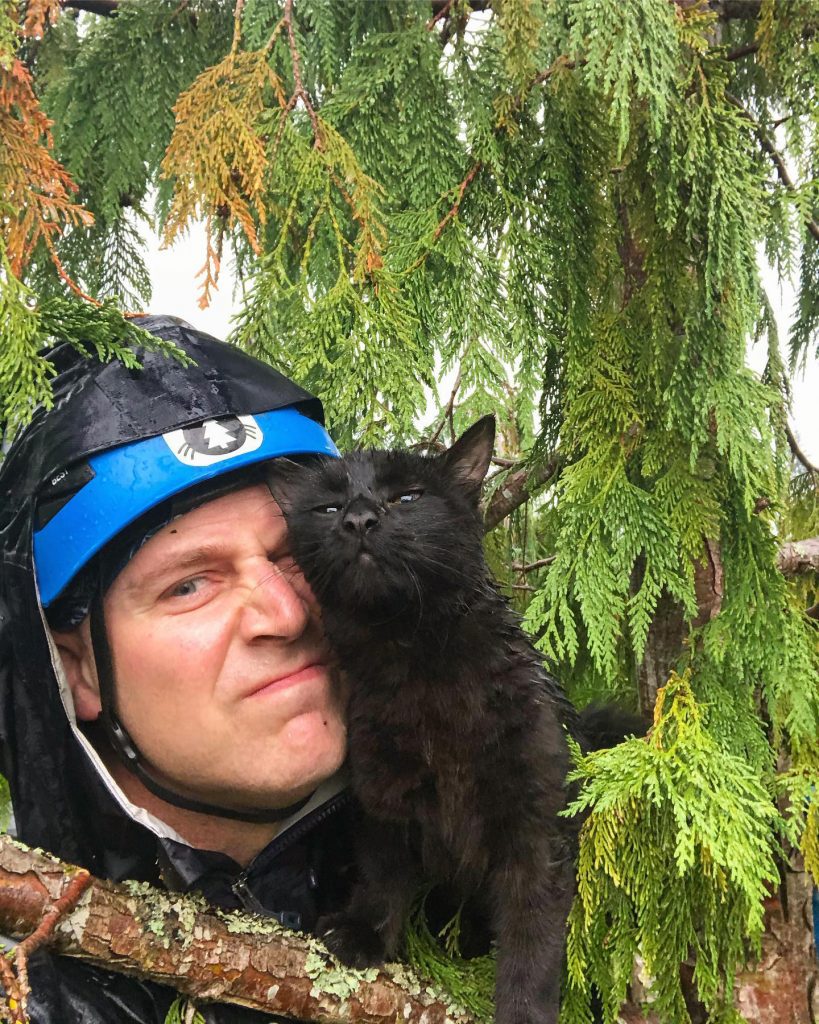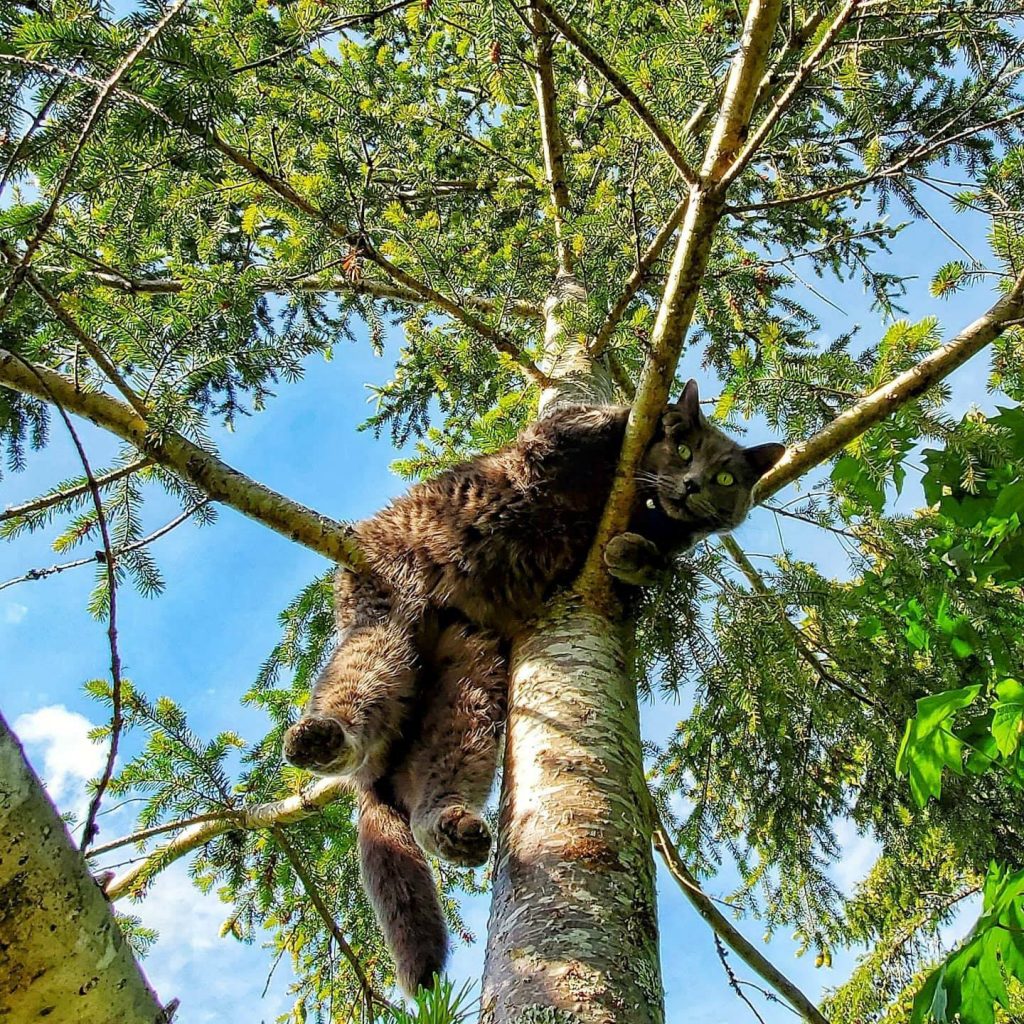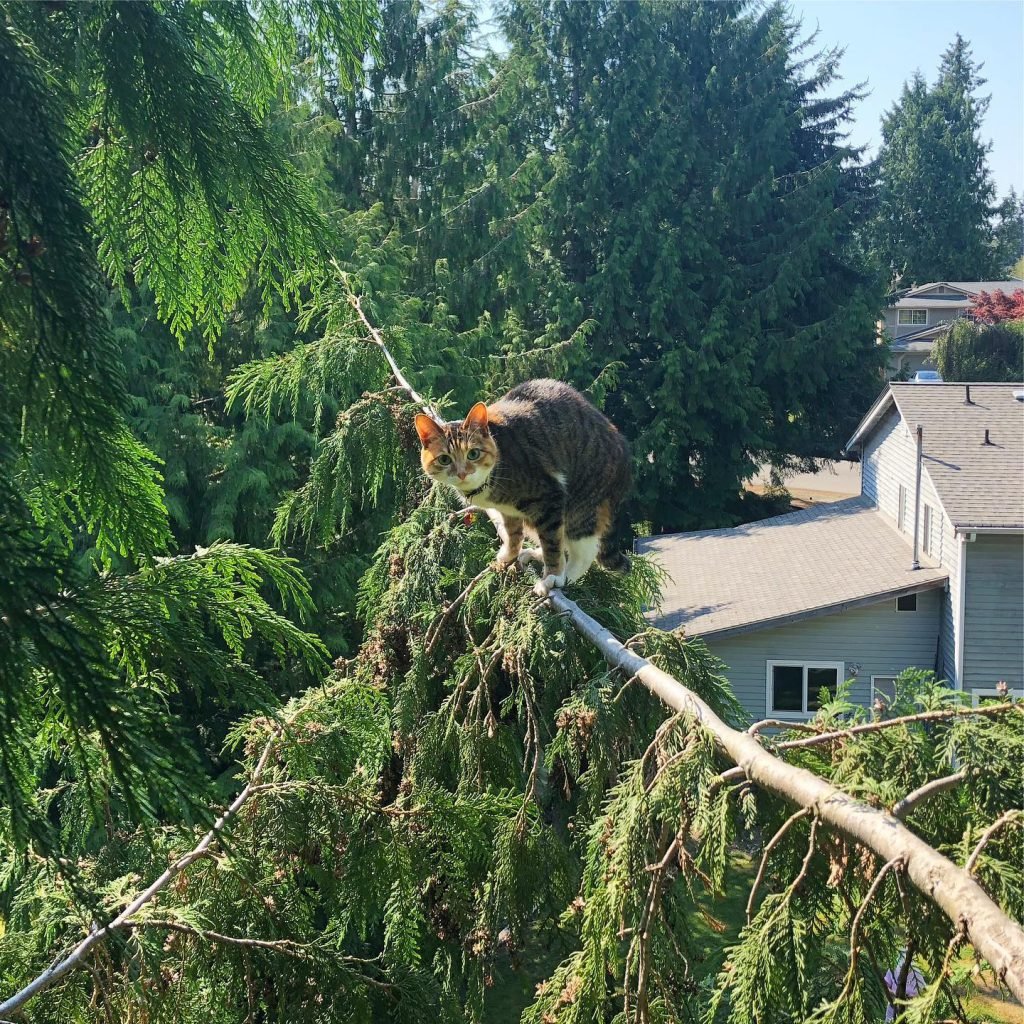For three days, sweet Sarah was stuck high in a fir tree in Southwest Washington, meowing for help. Sarah’s owner thought she would climb down, but the terrified Tortie kept climbing higher.
Sarah’s cries turned to purrs when mountain climber and arborist-turned-cat-extracting-superhero Shaun Sears of Canopy Cat Rescue arrived to bring her down.
Sears and his brother-in-law, Tom Otto, began rescuing cats in trees over a decade ago when they operated a small tree service and got the occasional call about a stuck cat.
“When we first started doing cats in trees it would be up to three a month,” says Sears.
Fast forward to 2021, and Sears and Otto travel all over Washington state, 24 hours a day, to help retrieve cats from trees.
The duo are on their way to 700 rescues for the year. And according to Sears’ estimates, “we’ve rescued over 5,000 cats since we started.”
A stranded kitty in need of help. Photo courtesy Canopy Cat Rescue
Ready to Serve
Sears and Otto now both work full time for their nonprofit, and rescue cats day or night.
“Sometimes folks find their missing cat at night with a flashlight and we don’t want (the cat) to spend another night in a cold, wet tree,” says Sears.
Being cat lovers, Sears and Otto have cats of their own. Sears has Medi, a 10-year-old fluffy orange cat, and Otto has Bean and Bug, 18-month-old black cats.
“What inspires us is we really love cats and we enjoy helping people and cats by reuniting them with their loved ones,” says Sears. “When we hear the panic and desperation in the cat owner’s voice we know that we need to help. We both have the expert skill set to help these cats when they are so high in trees.”
No Kitty Left Behind
When Sears and Otto started out, the average charge for a rescue was $75. This all changed in 2012 with a rescue Sears calls a “lightbulb” moment.
“I could tell the $75 fee would be a hardship for the family. I could feel the stress that was going to create,” he says. “On the drive home, I got really emotional. I called [the family] and said I wasn’t going to cash the check.”
That day Sears and Otto decided they would operate on donations.
“We adopted our mission statement: All cats deserve the chance to be rescued, regardless of the owner’s ability to pay,” says Sears. “That’s been one of our successes. We’ve been a platform and voices for cats in trees, but also for these families. We don’t want to make money off of people’s misfortune.”

Shaun Sears of Canopy Cat Rescue performing a rescue. Photo courtesy Canopy Cat Rescue
How Rescuing a Cat Stuck in a Tree Works
When CCR gets a call about a stuck cat, the process starts with a lot of questions. Sears and Otto will ask things like, how high is the cat in the tree? Is it your cat? Is the cat spayed or neutered? (Unaltered cats can be especially cranky.) Is it in your yard? How long has the cat been stuck? What’s the cat’s name?
The team also asks how kitty reacts when strangers come over to the house, does he tend to run and hide or does he come out and say hello?
“The answer to that question dictates how we go about the rescue when we get on site,” Sears says.
If it’s a skittish cat, they prepare for him to be resistant to handling and possibly going higher in the tree, out on a limb or even jumping.
If it seems like kitty is a high jump risk, they’ll find out what’s underneath the tree, such as a fence, rocks, or concrete, and prepare the area for a safe landing.
“Sometimes we will rig up tarps underneath to cushion the cat if a jump is likely,” says Sears. “We will also bring a net attached to a long pole.”
If kitty is friendly, they don’t worry about a lot of extra precautions because the cat is usually happy to get some help.
Sears and Otto use rock climbing gear to make their way up to the cat, all the while talking to the cat and assessing his body language and meows.
“Usually if a cat has a high pitch ‘help me’ meow, it’s happy to see us, but a low, growly meow is very concerning,” says Sears. “The timid cats we will really take our time getting close to and be very careful about our movements in the tree.”
Once near the cat they’ll reach out and let the cat smell their hand and then they’ll pick the cat up as one normally would.
“Put your hand beneath their belly and support their body weight, then snuggle,” says Sears.
That snuggle is because the cat needs to be comforted.
“He just had a very traumatic experience, he just escaped death,” says Sears.
“One favorite moment is when we get to have that one-on-one moment where this cat is so thankful,” says Sears.
Cats get what Sears calls “happy shivers.”
“Once you pick him up his motor starts to go and he starts shaking because he’s heating up…he’s feeling that love,” he says.
They then clasp kitty’s front paws and gently put him into a special rescue sack or net for the trip down to his relieved family.

Shaun Sears with a grateful rescue. Photo courtesy Canopy Cat Rescue
Getting Kitty Home
The majority of rescues are owners calling about their cats but in 20-25 percent of the cases the owner is unknown.
Sears and Otto carry a microchip scanner so they can check for a chip. If that doesn’t work they’ll enlist somebody in the neighborhood, usually the person who called, to care for the cat while there is a search for the owner.
“We’ve had a lot of luck with the NextDoor app,” says Sears.
If the cat is truly homeless, CCR contacts one of the local shelters they partner with.
Why Do Cats Get Stuck in Trees?
Sears says the most common reason cats get stuck in a tree is predatory activity, specifically coyotes.
“Coyotes are everywhere,” says Chris Anderson with the Washington Department of Fish and Wildlife, and since coyotes are opportunistic, “cats are on the menu.”
A WDFW study found coyotes living in nearly every part of the Seattle metro area and 13 percent of the coyote diet was domestic cats.
A video shared by Todd Bishop, co-founder of Seattle tech news site GeekWire, shows a cat narrowly escaping a coyote in his yard in the city’s busy Ballard neighborhood.
So, while coyotes are not a major threat to humans, they are a threat to cats, who may climb trees to escape them.
Cats also climb trees to escape dogs, or a kitten gets the zoomies and races up a tree and can’t get down. Sears says about 20 percent of CCR’s rescues are indoor cats that got out, and indoor cats are more likely to get chased up a tree because they aren’t aware of their surroundings.
A Life or Death Situation for Cats
Sears, Otto, their clients (and their cats!) know their work helps saves the lives of hundreds of cats a year, but a lot of other people don’t—especially some who comment on their social media pages. One comment that occasionally pops up is to the effect of, “I’ve never seen a cat skeleton in a tree.”
Sears says the truth is you don’t see any skeletons in trees, whether that’s a cat, squirrel or other animal.
“When [cats] lose the ability to hold on they will fall,” he says. “We have seen dead cats at the base of trees.”
Cats who fall suffer serious injuries. Cats stuck for long periods can suffer from dehydration and internal injuries they can’t recover from.
There were several instances of long-hair cats where their tail was in a knot and stuck to the tree so there was no way they could make it down.
“If we hadn’t come along there absolutely would have been a skeleton!” says Sears.

A helpless kitty rescued by Canopy Cat Rescue. Photo courtesy Canopy Cat Rescue
A Unique Operation
While there are other rescuers across the country, Shaun says CCR is the only nonprofit.
“We do this more than anybody else in the United States…and we can say we do this more than anybody else in the world,” says Sears.
Each year, the rescue gets more and more calls.
“Fire departments and tree services hand out our information and 911 dispatchers will hear of us and give out our information,” Sears says. “Fire departments do not get dispatched for cats in trees. They’re in the business of human emergencies but not pet emergencies. Very rarely a fire department can help a cat in a tree but they are not dispatched for it.”

Shaun Sears, left, and Tom Otto, of Canopy Cat Rescue
If Your Cat Gets Stuck in a Tree
If your cat goes missing, be sure to check the trees, she may be stuck.
While some cats can climb down by themselves, others definitely need help. Cats can climb up trees easily, but due to the shape of their claws, climbing down is very difficult. And a traumatized cat may simply be too scared to try.
Sears doesn’t recommend putting food at the base of the tree.
“Chances are that your cat won’t be able to see or smell the food and it will likely attract other animals and wildlife to the base of the tree,” says Sears.
If you’re in Washington state, give CCR a call, otherwise you can consult the worldwide directory that lists cat tree rescuers so you may find someone in your area who can help.
You can also try tree services in your area.
Sears says people may think their cat is dumb because the cat can’t climb down from the tree but it’s quite the opposite.
“The cat was really smart. He used the tree to save his life,” he says.
You can keep up with Sears and Otto and their recent rescues on their Canopy Cat Rescue YouTube channel or Instagram page.
